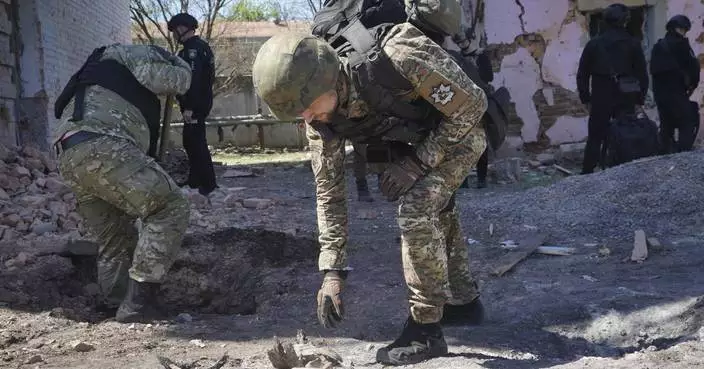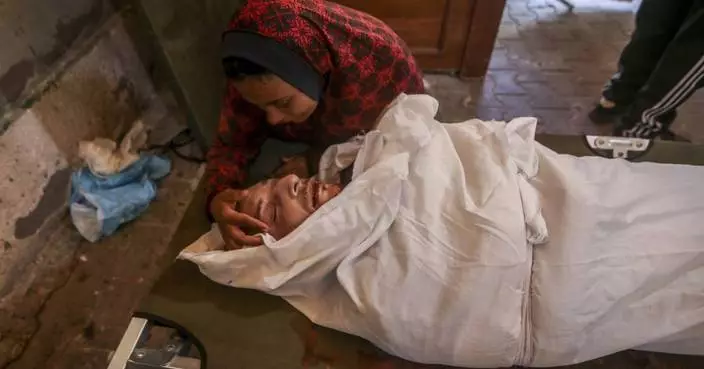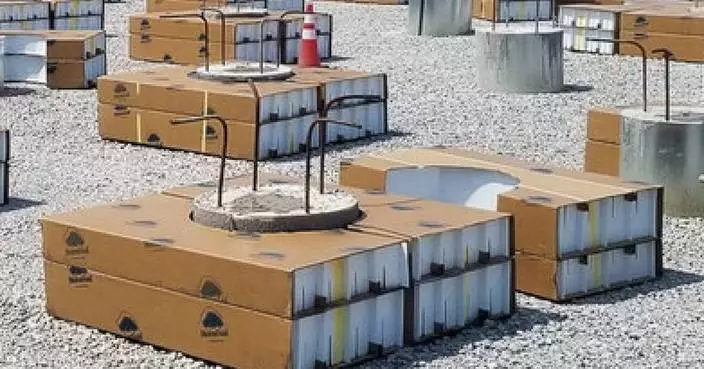It's been 22 years since Bosnia's bloody 1992-95 war ended, yet the remains of numerous victims of genocide and war crimes still await identification.
Forensic anthropologist Dragana Vucetic spends her working hours in a forensic facility in the northern town of Tuzla collecting DNA samples from the bones of people killed in eastern Bosnia during the war, including in the notorious 1995 Srebrenica massacre, and reassembling their skeletal remains.
Click to Gallery
It's been 22 years since Bosnia's bloody 1992-95 war ended, yet the remains of numerous victims of genocide and war crimes still await identification.
A U.N court will hand down its verdict Wednesday in the case against Ratko Mladic, who led Bosnian Serb forces in their quest to dismember Bosnia, carve out an "ethnically pure" Serb territory and unite it with neighboring Serbia. Mladic was on the ground with his troops when they overran Srebrenica in July 1995 and proceeded to hunt down and slaughter around 8,000 Muslim Bosnian men and boys. He was charged with genocide for his role in the massacre.
When the search for the war missing began, it wasn't unusual for the remains of one Srebrenica victim to be found scattered between several different mass graves, sometimes miles apart.
In this Monday, Nov. 6, 2017, photo, forensic anthropologist Dragana Vucetic handles human bones before collecting DNA samples of people killed in eastern Bosnia during the war, at a forensic facility in Tuzla, Bosnia. As a U.N court prepares to hand down its verdict in the case against Ratko Mladic, the Bosnian Serb military leader during the Balkan country's 1992-5 war, the remains of numerous victims of genocide and war crimes of which he stands accused still await identification.(AP Photo/Amel Emric)
In this Monday, Nov. 6, 2017, photo, forensic anthropologist Dragana Vucetic handles human bones before collecting DNA samples of people killed in eastern Bosnia during the war, at a forensic facility in Tuzla, Bosnia. As a U.N court prepares to hand down its verdict in the case against Ratko Mladic, the Bosnian Serb military leader during the Balkan country's 1992-5 war, the remains of numerous victims of genocide and war crimes of which he stands accused still await identification. (AP Photo/Amel Emric)
In this Thursday, Nov. 16, 2017, photo, a woman touches grave stones at the memorial center of Potocari near Srebrenica, Bosnia. As a U.N court prepares to hand down its verdict in the case against Ratko Mladic, the Bosnian Serb military leader during the Balkan country's 1992-5 war, the remains of numerous victims of genocide and war crimes of which he stands accused still await identification. (AP Photo/Amel Emric)
In this Monday, Nov. 6, 2017, photo, forensic anthropologist Dragana Vucetic handles human bones before collecting DNA samples of people killed in eastern Bosnia during the war, at a forensic facility in Tuzla, Bosnia. As a U.N court prepares to hand down its verdict in the case against Ratko Mladic, the Bosnian Serb military leader during the Balkan country's 1992-5 war, the remains of numerous victims of genocide and war crimes of which he stands accused still await identification. (AP Photo/Amel Emric)
In this Thursday, Nov. 16, 2017, photo, a woman gestures near grave stones at the memorial centre of Potocari near Srebrenica, Bosnia. As a U.N court prepares to hand down its verdict in the case against Ratko Mladic, the Bosnian Serb military leader during the Balkan country's 1992-5 war, the remains of numerous victims of genocide and war crimes of which he stands accused still await identification. (AP Photo/Amel Emric)
FILE - In this Tuesday, May 26, 2009, file photo, Bosnian forensic pathologist Vedo Tuco stands next to human remains found in a mass grave in the village of Mrsici, Bosnia. As a U.N court prepares to hand down its verdict in the case against Ratko Mladic, the Bosnian Serb military leader during the Balkan country's 1992-5 war, the remains of numerous victims of genocide and war crimes of which he stands accused still await identification. (AP Photo/Amel Emric, File)
In this Thursday, Nov. 16, 2017, aerial photo, grave stones line in rows at the memorial center of Potocari near Srebrenica, Bosnia. As a U.N court prepares to hand down its verdict in the case against Ratko Mladic, the Bosnian Serb military leader during the Balkan country's 1992-5 war, the remains of numerous victims of genocide and war crimes of which he stands accused still await identification. (AP Photo/Amel Emric)

FILE - In this Thursday, July 25, 2002, file picture, a group of Bosnian Muslim villagers look at the remains of bodies exhumed from a mass grave in the village of Kamenica, Bosnia. As a U.N court prepares to hand down its verdict in the case against Ratko Mladic, the Bosnian Serb military leader during the Balkan country's 1992-5 war, the remains of numerous victims of genocide and war crimes of which he stands accused still await identification. (AP Photo/Amel Emric, File)
A U.N court will hand down its verdict Wednesday in the case against Ratko Mladic, who led Bosnian Serb forces in their quest to dismember Bosnia, carve out an "ethnically pure" Serb territory and unite it with neighboring Serbia. Mladic was on the ground with his troops when they overran Srebrenica in July 1995 and proceeded to hunt down and slaughter around 8,000 Muslim Bosnian men and boys. He was charged with genocide for his role in the massacre.
Throughout the war, Serb soldiers had been throwing their victims' bodies in mass graves. In Srebrenica, they first dumped them in several large pits and then moved them with trucks and bulldozers to over 90 smaller clandestine mass burial sites attempting to hide the massacre.
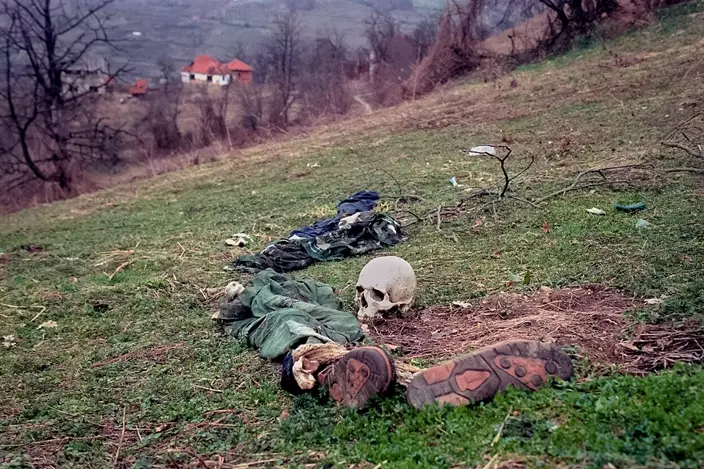
FILE- In this Tuesday, April 2, 1996, file photo, the remains of two bodies and pieces of clothing lie in a field at a suspected mass grave site in the village of Konjevic Polje, approximately 20km (12 miles), north west of Srebrenica. As a U.N court prepares to hand down its verdict in the case against Ratko Mladic, the Bosnian Serb military leader during the Balkan country's 1992-5 war, the remains of numerous victims of genocide and war crimes of which he stands accused still await identification. (AP Photo/Vadim Ghirda, File)
When the search for the war missing began, it wasn't unusual for the remains of one Srebrenica victim to be found scattered between several different mass graves, sometimes miles apart.
Vucetic's employer, the International Commission on Missing Persons (ICMP), has pioneered a DNA-based system to identify the remains. Through their efforts, over 70 percent of the estimated 30,000 persons missing from the Bosnian war have so far been accounted for. The figure includes nearly 7,000, or almost 90 percent, of the victims of Srebrenica.

EDS NOTE: GRAPHIC CONTENT FILE - In In this, Thursday, Oct. 31, 2013, file photo, Bosnian technical worker Zlatan Music examines bodies exhumed from a mass grave at the Sejkovaca identification center, near Sanski Most, Bosnia. As a U.N court prepares to hand down its verdict in the case against Ratko Mladic, the Bosnian Serb military leader during the Balkan country's 1992-5 war, the remains of numerous victims of genocide and war crimes of which he stands accused still await identification. (AP Photo/Amel Emric, File)
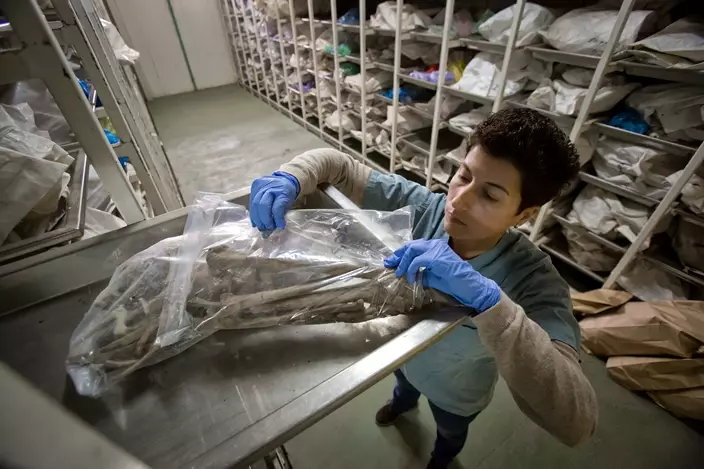
In this Monday, Nov. 6, 2017, photo, forensic anthropologist Dragana Vucetic handles human bones before collecting DNA samples of people killed in eastern Bosnia during the war, at a forensic facility in Tuzla, Bosnia. As a U.N court prepares to hand down its verdict in the case against Ratko Mladic, the Bosnian Serb military leader during the Balkan country's 1992-5 war, the remains of numerous victims of genocide and war crimes of which he stands accused still await identification.(AP Photo/Amel Emric)
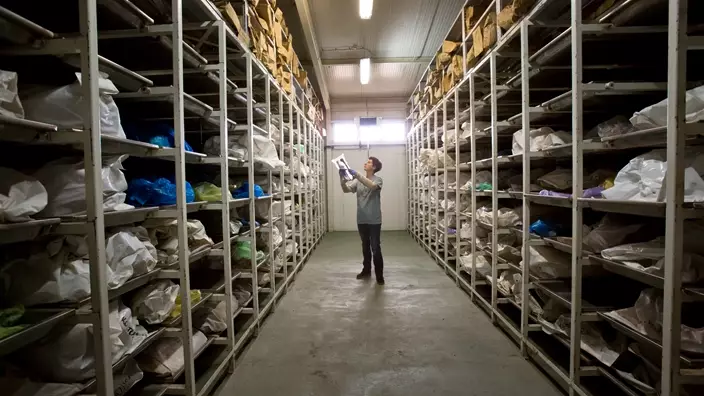
In this Monday, Nov. 6, 2017, photo, forensic anthropologist Dragana Vucetic handles human bones before collecting DNA samples of people killed in eastern Bosnia during the war, at a forensic facility in Tuzla, Bosnia. As a U.N court prepares to hand down its verdict in the case against Ratko Mladic, the Bosnian Serb military leader during the Balkan country's 1992-5 war, the remains of numerous victims of genocide and war crimes of which he stands accused still await identification. (AP Photo/Amel Emric)
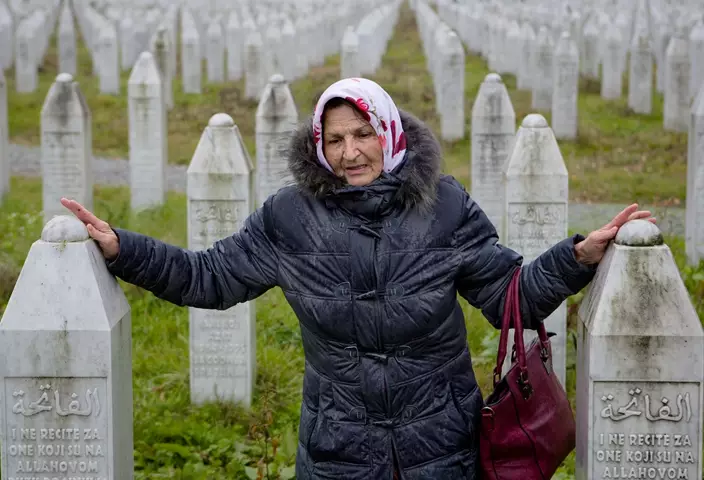
In this Thursday, Nov. 16, 2017, photo, a woman touches grave stones at the memorial center of Potocari near Srebrenica, Bosnia. As a U.N court prepares to hand down its verdict in the case against Ratko Mladic, the Bosnian Serb military leader during the Balkan country's 1992-5 war, the remains of numerous victims of genocide and war crimes of which he stands accused still await identification. (AP Photo/Amel Emric)
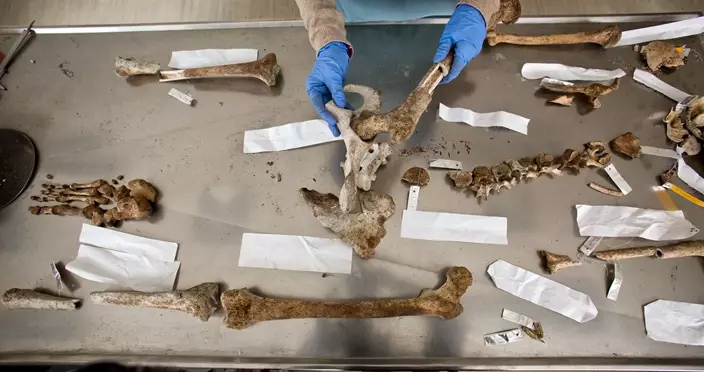
In this Monday, Nov. 6, 2017, photo, forensic anthropologist Dragana Vucetic handles human bones before collecting DNA samples of people killed in eastern Bosnia during the war, at a forensic facility in Tuzla, Bosnia. As a U.N court prepares to hand down its verdict in the case against Ratko Mladic, the Bosnian Serb military leader during the Balkan country's 1992-5 war, the remains of numerous victims of genocide and war crimes of which he stands accused still await identification. (AP Photo/Amel Emric)

In this Thursday, Nov. 16, 2017, photo, a woman gestures near grave stones at the memorial centre of Potocari near Srebrenica, Bosnia. As a U.N court prepares to hand down its verdict in the case against Ratko Mladic, the Bosnian Serb military leader during the Balkan country's 1992-5 war, the remains of numerous victims of genocide and war crimes of which he stands accused still await identification. (AP Photo/Amel Emric)
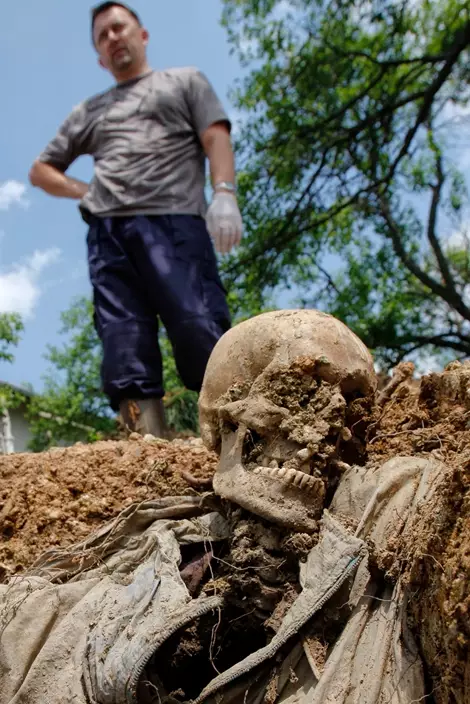
FILE - In this Tuesday, May 26, 2009, file photo, Bosnian forensic pathologist Vedo Tuco stands next to human remains found in a mass grave in the village of Mrsici, Bosnia. As a U.N court prepares to hand down its verdict in the case against Ratko Mladic, the Bosnian Serb military leader during the Balkan country's 1992-5 war, the remains of numerous victims of genocide and war crimes of which he stands accused still await identification. (AP Photo/Amel Emric, File)
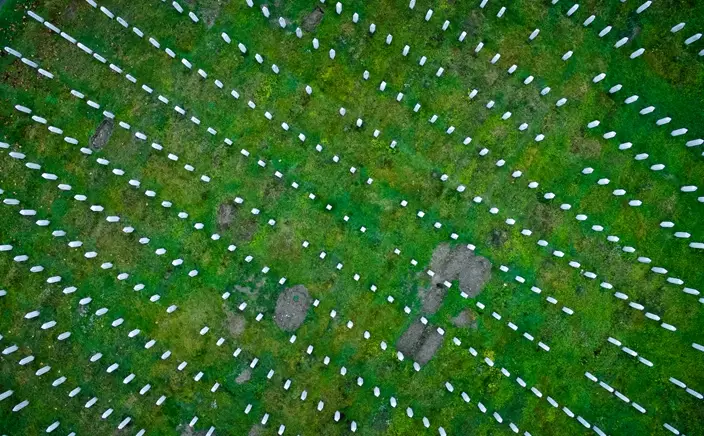
In this Thursday, Nov. 16, 2017, aerial photo, grave stones line in rows at the memorial center of Potocari near Srebrenica, Bosnia. As a U.N court prepares to hand down its verdict in the case against Ratko Mladic, the Bosnian Serb military leader during the Balkan country's 1992-5 war, the remains of numerous victims of genocide and war crimes of which he stands accused still await identification. (AP Photo/Amel Emric)
WASHINGTON (AP) — A soon-to-be-released Biden administration review of Israel's use of U.S.-provided weapons in its war in Gaza does not conclude that Israel has violated the terms for their use, according to three people who have been briefed on the matter.
The report is expected to be sharply critical of Israel, even though it didn’t conclude that Israel violated terms of U.S.-Israel weapons agreements, according to one U.S. official.
The Biden administration's first-of-its-kind assessment of its close ally's conduct of the war comes after seven months of airstrikes, ground fighting and aid restrictions that have claimed the lives of nearly 35,000 Palestinians, mostly women and children.
A presidential directive agreed to by the White House under pressure from congressional Democrats and others mandated the review of whether Israel had complied with international law in its use of U.S.-provided weapons and other security support during the course of the war.
Two U.S. officials and a third person briefed on the findings of the national security memorandum to be submitted by Secretary of State Antony Blinken to Congress discussed the matter before the report's release. They spoke on condition of anonymity because the information was not yet public.
A senior Biden administration official said the memorandum is expected to be released later Friday, but declined to comment on the findings.
Axios first reported on the memorandum's finding.
Lawmakers and others who advocated for the review said President Joe Biden and previous American leaders have followed a double standard when enforcing U.S. laws governing how foreign militaries use U.S. support, an accusation the Biden administration denies. They had urged the administration to make a straightforward legal determination of whether there was credible evidence that specific Israeli airstrikes on schools, crowded neighborhoods, medical workers, aid convoys and other targets, and restrictions on aid shipments into Gaza, violated the laws of war and human rights.
Their opponents argued that a U.S. finding against Israel would weaken it at a time it is battling Hamas and other Iran-backed groups. Any sharply critical findings on Israel are sure to add to pressure on Biden to curb the flow of weapons and money to Israel’s military and further heighten tensions with Prime Minister Benjamin Netanyahu’s hard-right government over its conduct of the war against Hamas.
Any finding against Israel also could endanger Biden’s support in this year's presidential elections from some voters who keenly support Israel.
The Democratic administration took one of the first steps toward conditioning military aid to Israel in recent days when it paused a shipment of 3,500 bombs out of concern over Israel’s threatened offensive on Rafah, a southern city crowded with more than a million Palestinians, a senior administration official said.
The presidential directive, agreed to in February, obligated the Defense and State departments to conduct “an assessment of any credible reports or allegations that such defense articles and, as appropriate, defense services, have been used in a manner not consistent with international law, including international humanitarian law.”
T he agreement also obligated them to tell Congress whether they deemed that Israel has acted to “arbitrarily to deny, restrict, or otherwise impede, directly or indirectly,” delivery of any U.S.-supported humanitarian aid into Gaza for starving civilians there.
At the time the White House agreed to the review, it was working to head off moves from Democratic lawmakers and independent Sen. Bernie Sanders of Vermont to start restricting shipments of weapons to Israel.
Israel launched its offensive after an Oct. 7 assault into Israel, led by Hamas, killed about 1,200 people. Two-thirds of the Palestinians killed since then have been women and children, according to local health officials. U.S. and U.N. officials say Israeli restrictions on food shipments since Oct. 7 have brought on full-fledged famine in northern Gaza.
Human rights groups long have accused Israeli security forces of committing abuses against Palestinians and have accused Israeli leaders of failing to hold those responsible to account. In January, in a case brought by South Africa, the top U.N. court ordered Israel to do all it could to prevent death, destruction and any acts of genocide in Gaza, but the panel stopped short of ordering an end to the military offensive.
Israel says it is following all U.S. and international law, that it investigates allegations of abuse by its security forces and that its campaign in Gaza is proportional to the existential threat it says is posed by Hamas.
Biden in December said “indiscriminate bombing” was costing Israel international backing. After Israeli forces targeted and killed seven aid workers from the World Central Kitchen in April, the Biden administration for the first time signaled it might cut military aid to Israel if it didn’t change its handling of the war and humanitarian aid.
Presidents Ronald Reagan and George H.W. Bush, in the 1980s and early 1990s, were the last presidents to openly hold back weapons or military financing to try to push Israel to change its actions in the region or toward Palestinians.
A report to the Biden administration by an unofficial, self-formed panel including military experts, academics and former State Department officials detailed Israeli strikes on aid convoys, journalists, hospitals, schools and refugee centers and other sites. They argued that the civilian death toll in those strikes — such as an Oct. 31 strike on an apartment building reported to have killed 106 civilians — was disproportionate to the blow against any military target.
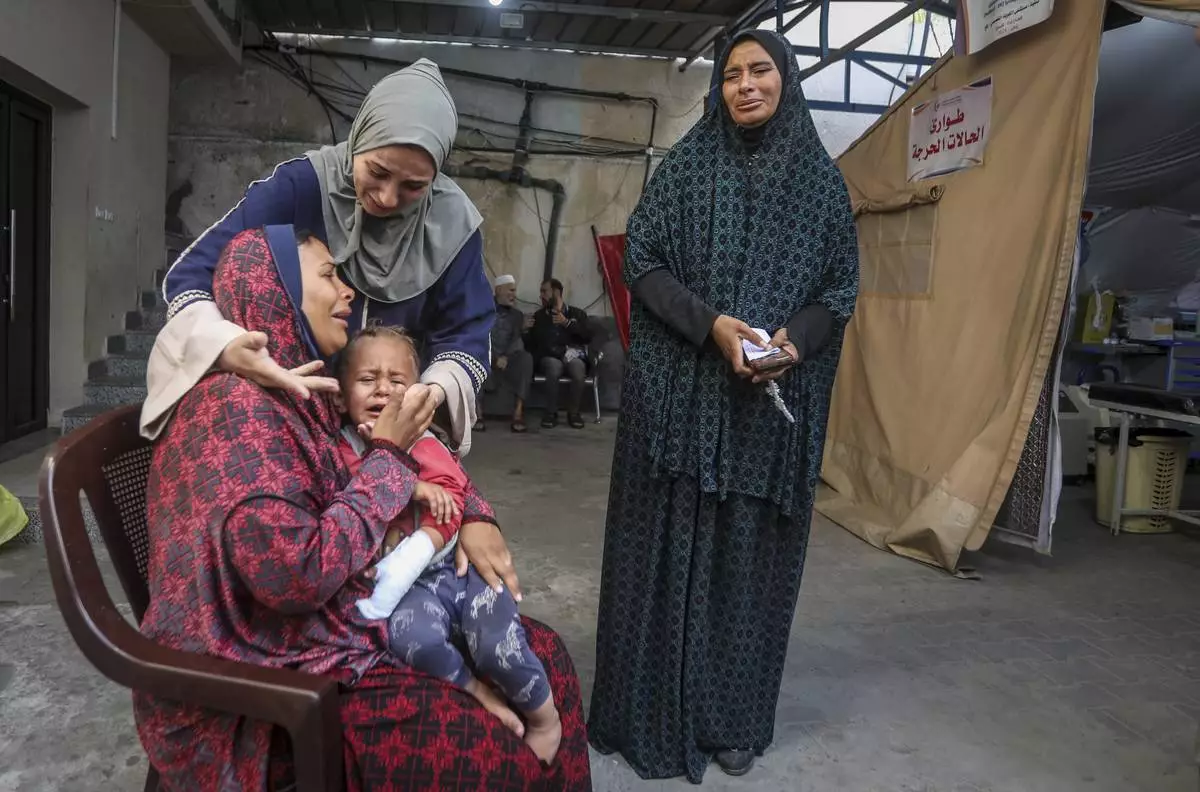
Palestinians mourn their relatives killed in the Israeli bombardment of the Gaza Strip, at a hospital in Rafah, Gaza, Friday, May 10, 2024. (AP Photo/Ismael Abu Dayyah)

U.S. President Joe Biden boards Marine One at Moffett Airfield in Mountain View, Calif., Thursday, May 9, 2024. (Jose Carlos Fajardo/Pool Photo via AP)
















